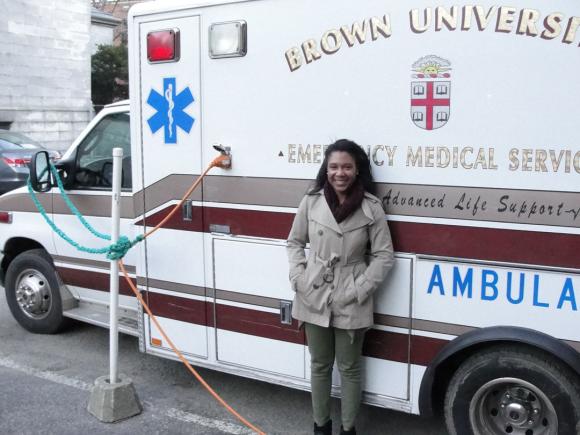PROVIDENCE, R.I. [Brown University] — Chenelle Norman thinks about emergencies night and day. She’s a volunteer EMT at Brown on the Monday overnight shift. The rest of the week, in her “day job” as a Master of Public Health student, she’s working on a project with the R.I. Department of Health to learn about the most frequent elderly users of 911, with the goal of providing medical care that might serve them better.
In the Brown University School of Public Health, research projects provide important opportunities to train the next generation of passionate health professionals for the state and the nation.
The 911 project is why Norman came to Brown last year. After earning a bachelor’s degree in biology at Spelman College in Atlanta, Norman was eager to shift to an academic setting in which she could explore health care and work on issues more directly relevant to patients. Brown struck her as a place with a strong public health program that was still small enough for her to make meaningful connections with faculty.
“Public health is so diverse, people do everything in public health,” she said. “Really, I think this field has allowed me to explore what my interests are.”
For her thesis project, she’s become part of a team of Brown and RIDOH researchers that could provide a very direct benefit for hundreds of elderly Rhode Island patients who have become frequent — more than four times a year — users of emergency services.
“I thought this was a great opportunity to delve into the emergency medicine world,” she said. “I applied and thankfully I was accepted.”
She and her collaborators are starting with an analysis to understand the most common reasons for frequent 911 use. Is it falls? Is it mismanagement of diabetes? Alcohol abuse? She and her collaborators, led by Michael Mello, associate professor of emergency medicine, and Jason Rhodes, chief of RIDOH’s Division of Emergency Medical Services, have been poring over the medical records of hundreds of the most frequent 911 users.
The analysis is meant to lead to appropriate interventions for patients to prevent their problems from reaching the scale of an emergency. One might be bolstering primary care. Another might be improving communication between emergency medicine and primary care doctors. A third could be deploying case managers to help address needs, such as unsafe conditions in a home that contribute to falls.
“There are a lot of possibilities, we just don’t know yet,” Norman said. “What I would like to see from this project is improving care for people who need better care.”
The data gathering and review are ongoing but Norman expects to complete her work and graduate in May. She’s now looking forward to her next move: a hospital administration fellowship combined with further education as a trauma or emergency room nurse so that she can focus on ways to improve emergency care for patients.
“Brown has given me direction as far as where I see myself going next,” she said. “That’s what I was looking for.”

